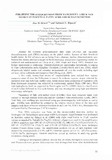Perlihatkan publikasi sederhana
Incorporation of fatty acids from dietary neutral lipid in eye, brain and muscle of postlarval turbot fed diets with different types of phosphatidylcholine
| dc.contributor.author | Geurden, Inge | |
| dc.contributor.author | Reyes, Ofelia S. | |
| dc.contributor.author | Bergot, Pierre | |
| dc.contributor.author | Coutteau, Peter | |
| dc.contributor.author | Sorgeloos, Patrick | |
| dc.date.accessioned | 2023-10-06T07:13:25Z | |
| dc.date.available | 2023-10-06T07:13:25Z | |
| dc.date.issued | 1998 | |
| dc.identifier.citation | Geurden, I., Reyes, O. S., Bergot, P., Coutteau, P., & Sorgeloos, P. (1998). Incorporation of fatty acids from dietary neutral lipid in eye, brain and muscle of postlarval turbot fed diets with different types of phosphatidylcholine. Fish Physiology and Biochemistry, 19(4), 365–375. https://doi.org/10.1023/A:1007771431134 | en |
| dc.identifier.issn | 0920-1742 | |
| dc.identifier.uri | http://hdl.handle.net/10862/6497 | |
| dc.description.abstract | Previous results demonstrated the stimulating effect of soybean phosphatidylcholine (PC) on the utilization of dietary neutral lipid in larval and postlarval fish. The present study further investigated the effect of the degree of saturation of dietary PC on the enhancement of dietary fatty acid incorporation in lipids of turbot. Newly-weaned turbot were fed for 20 days on four isolipidic diets containing the same amount of highly unsaturated fatty acids (HUFA), presented either as neutral lipid, i.e. fish oil ethyl esters, or as polar lipid. Diet FO was a phospholipid-free control diet. Diets HPC, SPC and FPC were supplemented with 3% hydrogenated soybean PC, 3% native soybean PC and 3% marine fish roe PC, respectively. The three PC-supplemented diets resulted in better growth and higher muscle triacylglycerol levels than the PC-free diet FO. The fish fatty acids were determined in 3 lipid classes (neutral lipid, PC, phosphatidylethanolamine) of 3 organs or tissues (eye, brain and muscle). Despite the identical amounts of n-6 and n-3 fatty acids provided by the soybean oil and by the HUFA ethyl esters, the substitution of 3% hydrogenated coconut oil in diet FO by 3% hydrogenated PC in diet HPC caused, averaged over the various tissues and lipid classes, a 7 to 12% higher incorporation of 18:2n-6, 20:4n-6, 20:5n-3 and a 32% higher 22:6n-3 level in turbot lipid. Diet HPC appeared as efficient as diet SPC for enhancing the incorporation of the n-3 HUFA from the ethyl esters. Feeding diet FPC, in which the n-3 HUFA were provided through the marine PC source, resulted in slightly higher levels of these fatty acids in the fish than feeding the ethyl ester HUFA diets, even if supplemented with PC. Present results confirm the positive effect of PC, either hydrogenated or native, on the utilization of fatty acids provided in the diet as neutral lipid. The slightly higher incorporation of HUFA, when esterified on dietary PC instead of neutral lipid, raises the question regarding the form of intestinal absorption of PL in fish. | en |
| dc.language.iso | en | en |
| dc.publisher | Springer | en |
| dc.subject | turbot | en |
| dc.subject | Scophthalmus maximus | en |
| dc.subject | neurotransmitters | en |
| dc.subject | Pleuronectidae | en |
| dc.subject | lecithins | en |
| dc.subject | docosahexaenoic acid | en |
| dc.subject | eicosapentaenoic acid | en |
| dc.title | Incorporation of fatty acids from dietary neutral lipid in eye, brain and muscle of postlarval turbot fed diets with different types of phosphatidylcholine | en |
| dc.type | Article | en |
| dc.identifier.doi | 10.1023/A:1007771431134 | |
| dc.citation.volume | 19 | en |
| dc.citation.issue | 4 | en |
| dc.citation.spage | 365 | en |
| dc.citation.epage | 375 | en |
| dc.citation.journalTitle | Fish Physiology and Biochemistry | en |
| dc.subject.asfa | diet | en |
| dc.subject.asfa | nutritional requirements | en |
| dc.subject.asfa | polyunsaturated fatty acids | en |
| dc.subject.asfa | feeding experiments | en |
| dc.subject.asfa | fatty acids | en |
| dc.subject.asfa | marine fishes | en |
| dc.identifier.essn | 1573-5168 | |
| dc.subject.scientificName | Scophthalmus maximus | en |
| dc.subject.scientificName | Pleuronectidae | en |
| dc.subject.scientificName | Pleuronichthys | en |
| local.subject | phosphatidylcholine | en |
| local.subject | HUFA | en |
| local.subject | DHA | en |
| local.subject | marine fish | en |
| local.subject | turbot | en |
| local.subject | breet | en |
Files in this item
| Files | Size | Format | View |
|---|---|---|---|
|
There are no files associated with this item. |
|||
Publikasi ini ada di koleksi berikut
-
Journal Articles [1256]
These papers were contributed by Department staff to various national and international journals.




